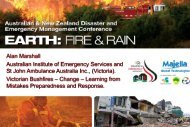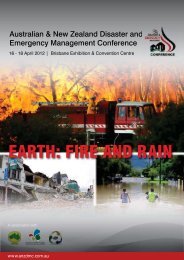Book of Abstracts 2013 - Australian and New Zealand Disaster ...
Book of Abstracts 2013 - Australian and New Zealand Disaster ...
Book of Abstracts 2013 - Australian and New Zealand Disaster ...
Create successful ePaper yourself
Turn your PDF publications into a flip-book with our unique Google optimized e-Paper software.
however, because <strong>of</strong> their exceptional nature, major accidents do not typically fit into a st<strong>and</strong>ard likelihood /<br />
consequence matrix. Risk management needs to be ‘fit for purpose’ <strong>and</strong> emergency plans <strong>and</strong> emergency preparedness<br />
are critical risk management elements. Many sites promote their emergency plans as control measures, but they may<br />
not be suitable or appropriate. The introduction <strong>of</strong> harmonised WHS laws within Australia is changing compliance<br />
obligations for facilities <strong>and</strong> compliance assessment obligations for regulators. Fire services authorities also have<br />
obligations under this legislation to provide comments <strong>and</strong> recommendations to facilities, which must comply with<br />
those recommendations (previously, facilities were only required to have due regard to any comment or<br />
recommendation). Compliance now includes all aspects <strong>of</strong> emergency plan testing. Although not all <strong>Australian</strong><br />
jurisdictions have yet adopted the model laws, history has shown that regardless <strong>of</strong> the jurisdiction in which an<br />
accident has occurred, the investigative team will typically explore relevant st<strong>and</strong>ards <strong>and</strong> laws, whether or not they<br />
strictly apply. The Report <strong>of</strong> the Longford Royal Commission into the major accident at the Esso site in Victoria is an<br />
example, canvassing multiple st<strong>and</strong>ards, codes <strong>of</strong> practice <strong>and</strong> legislation from within Australia <strong>and</strong> overseas. This<br />
paper explores the risks <strong>and</strong> opportunities presented to both industry <strong>and</strong> fire services through the introduction <strong>of</strong><br />
Model WHS legislation, <strong>and</strong> how an open <strong>and</strong> collaborative approach can achieve regulatory compliance <strong>and</strong> improve<br />
public safety.<br />
Ms Kate Hill<br />
Senior Lecturer,, Massey University<br />
Co Author - Ms Hayley Squance, Programme Director / Lecturer, Massey University<br />
Evaluation <strong>of</strong> the morbidity <strong>and</strong> mortality <strong>of</strong> animals post Canterbury earthquakes – A Pilot<br />
study<br />
Introduction Recent disasters such as floods, fires, snow storms, earthquakes <strong>and</strong> tsunamis, nationally <strong>and</strong><br />
internationally, have contributed to a significant number <strong>of</strong> human <strong>and</strong> animal deaths <strong>and</strong> injuries. These events have<br />
highlighted the importance <strong>of</strong> the use <strong>of</strong> specific disaster risk <strong>and</strong> impact modelling to inform the mitigation tools such<br />
as developing appropriate building regulations, facilitating decision making on urban developments <strong>and</strong> assisting with<br />
response <strong>and</strong> recovery processes. Despite this development there has been little scientific research on how disasters<br />
affect animals; therefore there is a lack <strong>of</strong> underst<strong>and</strong>ing on how to mitigate hazards <strong>and</strong> risks that could, in turn,<br />
reduce morbidity <strong>and</strong> mortality <strong>of</strong> animals. Aim The aim <strong>of</strong> this study was to evaluate how disasters affect the health <strong>of</strong><br />
animals immediately, short-term <strong>and</strong> medium-term post disaster using the recent Canterbury earthquakes as a case<br />
study. The outputs from the study will be used in earthquake (along with other disasters) risk <strong>and</strong> impact models to<br />
develop mitigation measures for animal welfare during disasters. Method This pilot study is a retrospective cohort<br />
review <strong>of</strong> patient visits from 5 functional veterinary clinics within <strong>and</strong> surrounds <strong>of</strong> the worst affected areas in<br />
Canterbury region. Data was collected from the 7 month period before the September 4th 2010 earthquake through to<br />
January <strong>2013</strong>. The veterinary visits were coded into 3 different categories: Gastro-intestinal, renal, & euthanasia. A<br />
time-series analysis was performed on data collected. Results Pending, although through experience from past<br />
disasters, the deployment <strong>of</strong> the Veterinary Emergency Response team to assess animal welfare during the February<br />
earthquake <strong>and</strong> anecdotal evidence it is expected that there will be a significant mortality <strong>and</strong> morbidity rates amongst<br />
production <strong>and</strong> companion animals. There is an expectation that there is an increase in the number <strong>of</strong> animals<br />
presented to veterinary clinics with underlying diseases / conditions that were exacerbated by the earthquake events<br />
in Christchurch due to environmental contamination along with crushing injuries sustained as a direct result <strong>of</strong> the<br />
earthquake <strong>and</strong> subsequent after shocks.






